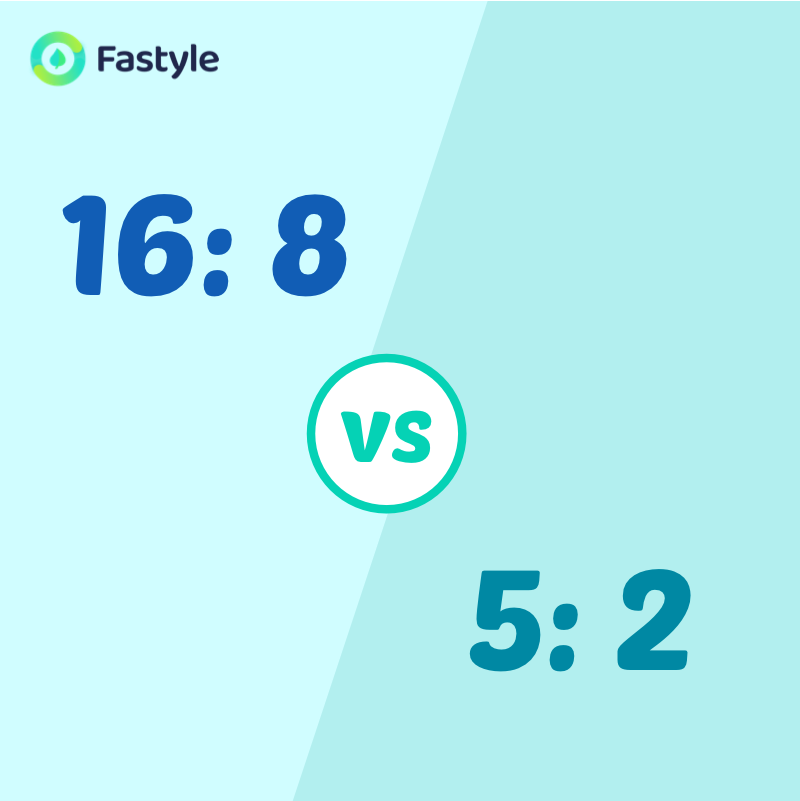When it comes to intermittent fasting, 16:8 and 5:2 are the two most commonly used intermittent fasting diet plans and most intermittent fasting beginners start their IF journeys from the two diet plans.
Then, how to choose between the two fasting diet plans and what elements should be taken into consideration when deciding on an intermittent fasting schedule for weight loss and a healthy body? This article will tell you.
Why Intermittent Fasting?
The essential reason for most people to carry out intermittent fasting lies in its contribution to weight loss. Instead of stopping you from eating or forcing you to diet, intermittent fasting provides diet plans that are friendly to weight loss and natural to the human body system.
Intermittent fasting isn’t a newly created thing but a natural diet plan that people have been conforming to since ancient times when food wasn’t easy to get and fridges weren’t created. They had to stand hunger for some time unless food got found for the next meal.
Apart from weight loss, intermittent fasting also has the benefits below:
- Boost immunity,
- Reduce insulin resistance,
- Reduce inflammation,
- Prevent cancer,
- Extend lifespan,
- Boost metabolism,
- Boost skin health.
Pros and Cons of 16:8 Diet Plan
It’s irresponsible to directly recommend an intermittent fasting plan for you without any research. So, the comparison between 16:8 and 5:2 should be analyzed before providing a clear conclusion on how to choose between 16:8 and 5:2 as an intermittent fasting diet plan.
What does 16:8 Mean?
A 16:8 diet plan regulates you to eat anything healthy during the 8 hours and to fast during the rest 16 hours a day. During the fasting window, you aren’t allowed to eat or drink anything except some simple drinks beneficial for intermittent fasting like pure water, black coffee, lemon water, tea, etc.
Based on the 16:8 diet plan, two meals are usually eaten in a day with healthy snacks between meals. The time for two meals is determined by individuals, either breakfast and lunch, brunch and lunner, or lunch and dinner as long as the meals are arranged within the 8 hours’ window.
Pros and Cons of 16:8
Pros
- It’s easy to follow.
- It can be started at any minute.
- There’s no limit on food intake.
- It’s flexible to follow so it’s mostly fit for IF beginners.
- It’s compatible with family diet plan.
Cons
It’s difficult to stick to because such a diet plan should be followed every day.
Pros and Cons of 5:2 Diet Plan
A 5:2 diet plan regulates you to normally eat for five days and eat meals with limited calories, 500 to 600 calories per day for two days a week.
Pros and Cons of 5:2
Pros
- It doesn’t affect your most meals.
- It’s flexible to conform to because any two days of low-calorie intake can be selected and adjusted.
- It’s easy to take.
Cons
- You have to beat huge hunger during the two days of low-calorie intake.
- It possibly arouses overeating during the five days of normal diets.
- Calories should be figured out on the two days of fasting, which adds trouble to your life. After all, it’s not so easy to quickly figure out the food amount with 500 or 600 calories. By the way, low calories can be seriously controlled through healthy diet swaps that is an easy way to cut calories.
5:2 vs 16:8: How to Find the Right Fasting Diet for You
16:8 or 5:2? Which intermittent fasting diet plan should be selected depends on the following considerations:
Your job and life schedule
If you keep a scheduled daily life like workdays from Monday to Friday and weekend on Saturday and Sunday with family, 5:2 is more fit because there are usually big meals on weekends as you stay with family and it’s difficult for you to stick to fasting. If you live by yourself and keep a routine work-life style, a 16:8 is suggested because you won’t have so many big meals. However, you should arrange your meals during the time when parties always fall.
Your capability to beat hunger
Compared with 16:8, 5:2 calls for higher capability to beat your hunger. Therefore, if you fail to beat hunger, 16:8 is a better option because it doesn’t let people feel so hungry.
Your true feeling
Which intermittent fasting diet plan exactly works for you? that depends on your true feelings. Try them both and determine which diet plan lets you feel greater or is more friendly to weight loss and health.
Can’t-Miss Tips for Intermittent Fasting
- Don’t focus on your scale too frequently.
- No matter which plan is selected, you should stick to it.
- Don’t expect obvious results too eagerly.
- Intermittent fasting is a lifestyle and you don’t need to feel so depressed.
- Although there are no rigorous limitations on your diet during the eating window, healthy food should be selected as much as you can.
- Avoid alcohol, avoid alcohol, avoid alcohol.
FOLLOW US
Related Articles:
